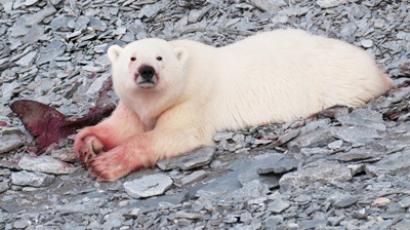Barely bearable Arctic attraction
Brutal, but beautiful: for citizens of the icy Arctic archipelago of Spitsbergen, polar bears are a common sight. Despite the obvious dangers, they are also a huge draw for visitors.
From the moment you arrive at Longyearbyen airport, the king of the Arctic has you firmly in his sights. He watches you collecting your bags from the belt and browsing in the souvenir shop, enjoying Spitsbergen’s spectacular scenery or simply doing the shopping.The polar bear's cult of personality is so huge here that it makes some dictators further south look like timid hares. Even the archipelago's top officials defer to him. “The polar bear is a good image for promoting Svalbard and its surroundings. Since it is also restricted to us and you cannot hunt for polar bears, it has become the symbol of our region,” Lars Erik Alfheim, the archipelago's vice governor explains.But people here are always mindful of the dangers. Longyearbyen has a higher percentage of gun ownership than any other municipality in Norway. The country may be debating tighter gun controls following July’s youth camp massacre, but here the rules for renting firearms have been eased.Vadim Kochevgin, a local taxi driver, says he often leaves his cellphone at home – but never his rifle.He recalls: “Once my friend and I were driving our snowmobiles in the countryside when we saw a polar bear. We got pretty close to him. He even started walking toward us when I realized that I left my signal gun at home. It was a close call. Now I try to be more careful.”Not all encounters have a happy ending. A 17-year-old British boy was killed and four of his companions injured when a hungry polar bear rampaged through their camp near Longyearbyen in early August. Just days earlier, they had left an ecstatic post on a blog about having seen the bear from a distance.“The danger of people traveling in the natural habitat of the bears is that they also could be seen as prey. It’s very rare. I mean there have been in Svalbard, which has a big human population and big polar bear population, I think five attacks since the 1970s,” says Olle Dahlberg, who works as a wilderness guide in Spitsbergen.A full police report is yet to be released but local experts believe malfunctioning rifles may have been to blame.With 2,500 people and 3,000 polar bears living on the archipelago, security is obviously an issue to keep in mind. And while locals and tourists are strongly advised to carry firearms at all times, being loaded for bear is definitely not the way to go here. While the death of the British teenager shocked locals, some feel killing the bear responsible was unnecessary. “The notion that human life is sacred just because it's human life is medieval,” Olle Dahlberg believes.His fascination with polar bears brought him here from Sweden. As a wilderness guide, he trains hard to never miss. Yet he says anyone living here realizes that aiming a rifle at a polar bear is like shooting yourself in the foot.“Polar bears bring tourism and because of the polar bears the guides always have to carry a rifle. So absolutely it is an attraction, but it’s an attraction at least partly based on danger,” he says.”Grin and bear it” might not be the perfect recipe for peaceful coexistence, but so far the majority of Spitsbergen’s locals, on two legs or four, live side-by-side – and both populations are growing.













